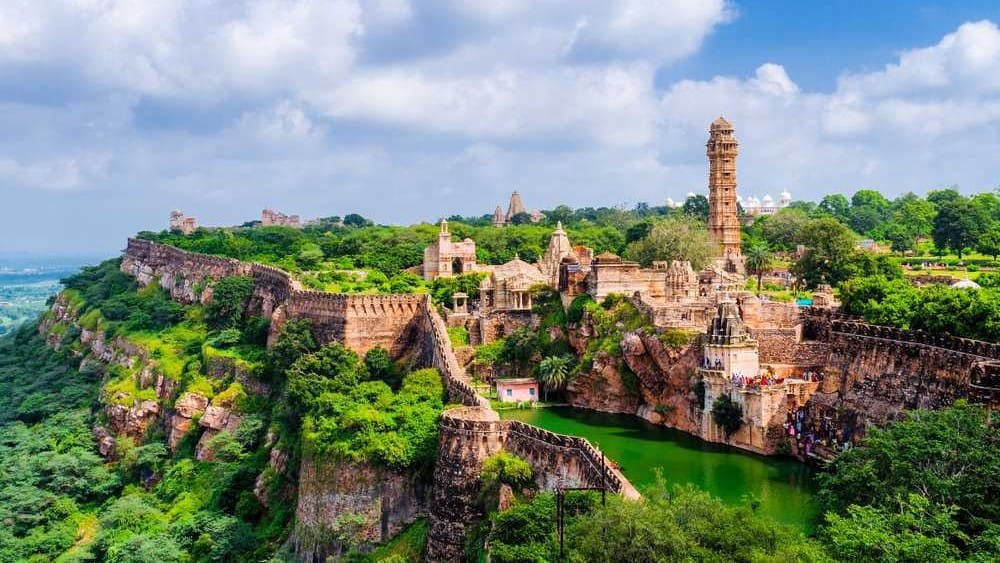In the Indian state of Rajasthan, Chittorgarh is a city with a long history and a diverse cultural heritage. It was the capital of the Mewar kingdom in the past and has been the site of numerous important historical events. Chittorgarh is now widely considered to be one of the country’s most important tourist destinations, attracting millions of visitors annually to see its stunning landmarks and monuments. The city is home to some of India’s most recognizable landmarks, including the magnificent Vijay Stambh and Kirti Stambh, the enormous Chittorgarh Fort, and others. A comprehensive guide to one of India’s most significant cultural centers will be presented in this blog as we examine Chittorgarh’s history, culture, and attractions in greater detail.
Chittorgarh Fort
One of India’s largest forts, Chittorgarh Fort is in the Indian city of Chittorgarh in the state of Rajasthan. The Mauryan empire built the fort in the seventh century, and it later served as the capital of the kingdom of Mewar. As a result, the fort has a long and varied history. The walls and towers of the fort, which have been the scene of numerous battles and sieges, demonstrate the bravery and valor of Rajput warriors. A massive wall that can reach 30 meters high in some places surrounds the fort, which occupies more than 700 acres.

The Vijay Stambh, a tower dedicated to Lord Vishnu, and the Kirti Stambh, a tower dedicated to Jainism, are two notable landmarks inside the fort. In addition, there is the beautiful Padmini’s Palace, which was Queen Padmini’s home, and the Rana Kumbha’s Palace, which is said to have been Maharana Pratap’s birthplace. In addition, the Meerabai Temple and the Kalika Mata Temple are two of the fort’s many temples and shrines.
Chittorgarh Fort is now a popular tourist destination and is regarded as a representation of Rajput valor and pride. The fort’s numerous landmarks and monuments can be explored, guided tours can be taken, and visitors can learn about the fort’s extensive history and cultural significance. One of India’s most significant cultural centers, the fort is also a UNESCO World Heritage Site.
Vijay Stambh and Kirti Stambh
In the Indian state of Rajasthan, the towers known as Vijay Stambh and Kirti Stambh can be found in the city of Chittorgarh. Maharana Kumbha constructed the nine-story Vijay Stambh, also known as the Victory Tower, in the 15th century to commemorate his victory over the Muslim rulers of Malwa and Gujarat. With intricate carvings and sculptures, the tower is dedicated to Lord Vishnu. Inside the tower, visitors can ascend the spiral staircase to the top, where they can take in panoramic views of the city below.

In contrast, a wealthy Jain merchant constructed the seven-story Kirti Stambh in the 12th century. Sculptures and carvings of Jain Tirthankaras adorn the tower, which is dedicated to Jainism. Jains also use the tower as a place of worship and consider it sacred.

Both Kirti Stambh and Vijay Stambh are popular Chittorgarh tourist attractions and are regarded as significant cultural landmarks in India. The towers can be seen, their history and significance can be learned about, and their architectural beauty can be appreciated by visitors. These towers are not only reminders of Chittorgarh’s rich cultural heritage but also of the city’s historical and religious significance.
Other landmarks and monuments in Chittorgarh
Chittorgarh is the location of a number of other noteworthy landmarks and monuments in addition to the Vijay Stambh and Kirti Stambh. The following are some of the most popular attractions:
Palace of Padmini: A gorgeous palace that was once Queen Padmini’s home and is now part of the Chittorgarh Fort. The palace is said to have been Maharana Pratap’s birthplace due to its stunning architecture and intricate carvings.

The Palace of Rana Kumbha: A huge palace in the Chittorgarh Fort that was once the Mewar rulers’ residence. The palace is said to have been Maharana Pratap’s birthplace and is renowned for its magnificent architecture.

Meerabai Temple: A temple dedicated to Meerabai, a well-known poet and devotee from Rajasthan. The temple is known for its beautiful architecture and peaceful atmosphere, making it a popular pilgrimage destination for her followers.

Kalika Mata Temple: A temple within the Chittorgarh Fort that is dedicated to the Hindu goddess Kali. Devotees of Kali frequently visit the temple, which is widely regarded as one of Rajasthan’s oldest.

Gaumukh Reservoir: A substantial artificial reservoir inside the Chittorgarh Fort that is said to have been constructed by Maharana Pratap. The reservoir is surrounded by lush gardens and is a popular spot for picnics and bird watching.

The historical and religious significance of Chittorgarh can be seen in these landmarks and monuments, which bear witness to the city’s extensive cultural heritage. These attractions can be explored, their history and significance can be learned about, and the architectural beauty can be appreciated by visitors.
Queen Padmavati & King Ratan Singh
King Ratan Singh and Queen Padmavati were figures from India’s medieval era who lived in the 13th century. King Ratan Singh ruled Mewar, a kingdom in India’s present-day state of Rajasthan, while Padmavati was a legendary queen who was praised for her beauty and virtue.
Legend has it that Alauddin Khilji, the Sultan of Delhi, saw Padmavati’s beauty and was determined to marry her. In order to capture her, he laid siege to Mewar’s Chittorgarh Fort. King Ratan Singh, on the other hand, bravely defended the fort with his army and refused to hand over Padmavati.
Padmavati had to make a difficult decision when King Ratan Singh was eventually taken captive by the forces of Alauddin Khilji, despite his best efforts. She is said to have joined other women of the fort in performing jauhar, or mass self-immolation, to avoid being captured and disrespected by the Sultan. King Ratan Singh, on the other hand, was imprisoned and killed later.
The tale of Queen Padmavati and King Ratan Singh is regarded as a tale of bravery, honor, and sacrifice and is a significant component of India’s cultural heritage. Numerous artistic and literary works, including plays, poems, and even a Bollywood film, have been inspired by the events of their lives.
Chittorgarh as a tourist destination
Chittorgarh, in the Indian state of Rajasthan, is a popular tourist destination for its stunning architectural landmarks, rich history, and cultural heritage. The city is home to the Chittorgarh Fort, which is one of the largest forts in India. It is home to a number of historic monuments and palaces, including the Meera Temple, Padmini Palace, and the Vijay and Kirti Stambh towers.
Chittorgarh is also known for its stunning temples, like the Temple of Goddess Jauhar Kund, the Temple of Rishabdeo, and the Temple of Gaumukh. Tourists who are interested in Hindu mythology, architecture, and art frequently visit these temples.

In addition, tourists can take advantage of Chittorgarh’s rich cultural heritage by shopping at the neighborhood markets for traditional textiles, jewelry, and crafts. The Chittorgarh Festival and the Navaratri Festival, which highlight Rajasthani music, dance, and cuisine, are two of the many cultural and festival events that the city puts on throughout the year.
Chittorgarh is easily accessible from India’s major cities thanks to its excellent road, rail, and air connections. Chittorgarh is a must-visit destination for any tourist who is interested in history, culture, architecture, or just wants to experience the vibrant energy of Rajasthan.
Is Chittorgarh Haunted?
There are no credible claims of a haunted Chittorgarh Fort. However, like a lot of historic places, it has a long and sometimes bloody history, which can give visitors the impression that the fort is haunted or that something strange is going on. However, rather than any actual ghostly activity, these perceptions are probably based on visitors’ imaginations and the fort’s history.
Having said that, opinions regarding the existence of ghosts and the paranormal are highly subjective. Chittorgarh Fort may or may not be haunted, depending on who you ask. It is best to visit the fort during daylight hours and with an open mind if you want to experience its history and beauty for yourself.
Conclusion
Chittorgarh is a cultural and historic city in the Indian state of Rajasthan that has a fascinating history and a rich heritage. If you’re interested in Indian history and culture, Chittorgarh is a must-see with its impressive fort, stunning temples, and stunning palaces.
This city has something for everyone, whether you want to learn about the legendary Queen Padmavati, see the impressive Vijay Stambh and Kirti Stambh, or learn about the rich history of Chittorgarh Fort.
The best time to visit Chittorgarh is from October to March, but it can be reached at any time of the year via air, rail, or road. Chittorgarh is a budget-friendly destination that provides tourists of all ages with a one-of-a-kind and unforgettable experience thanks to its low ticket prices and stunning scenery.
In a nutshell, Chittorgarh is a must-see destination that promises to captivate everyone who visits.
Best Time to Visit
Depending on the kind of experience you’re looking for, the best time to visit Chittorgarh, which is in the Indian state of Rajasthan, is when it’s coolest.
Chittorgarh’s tourist season runs from October to March, when the weather is pleasant and cool, making it a great place to go sightseeing and enjoy the outdoors. The Chittorgarh Festival and the Navaratri Festival are two examples of the many cultural events and festivals that take place in the city during this time.
The months of April through June are ideal if you want to avoid the crowds and have a more relaxed time. You can explore the city at your own pace without having to fight your way through the crowds because the weather is warm during this time. However, because it can get very hot during the day, it is best to wear a hat and sunscreen and plan your activities accordingly.
Comfortable clothing is always a good idea to bring when you visit Chittorgarh, especially if you plan to walk around and see a lot. Additionally, it is essential to bring an umbrella or raincoat with you when you visit during the monsoon season (July to September), when the region receives moderate to heavy rainfall.
Ticket Prices
The time of year and the kind of monument you want to see can affect how much it costs to buy a ticket to Chittorgarh, India, landmarks and monuments. Some general guidelines for ticket prices are as follows:
Fort Chittorgarh: The entry fee for Indian citizens is INR 15 (roughly USD 0.20), while the entry fee for tourists from other countries is INR 250 (roughly USD 3.50).
The Stambhs, Vijay and Kirti: Indian citizens pay INR 5 (approximately USD 0.07) for entry to either monument, while foreign tourists pay INR 100 (approximately USD 1.50).
Palace of Padmini: For Indian citizens, the entry fee is INR 5 (approximately USD 0.07), while for tourists from other countries, it is INR 100 (approximately USD 1.50).
Meera Temple: All visitors are eligible for free admission.
It is essential to keep in mind that these ticket prices are subject to change and may rise during special events or the peak tourist season. For the most up-to-date information on ticket prices, always consult the official website or a local tour guide.
How to Reach
Chittorgarh is easily accessible by air, rail, and road in the Indian state of Rajasthan. Chittorgarh can be reached in these ways:
By Air: The Maharana Pratap Airport in Udaipur, which is approximately 98 kilometers away, is the airport that is closest to Chittorgarh. Chittorgarh can be reached by bus or taxi from the airport.
By Trains: Chittorgarh has its own train station, which is well-connected to major Indian cities like Delhi, Mumbai, and Jaipur. To ensure a comfortable journey, you can purchase tickets in advance for the train.
By Road: Chittorgarh is easily accessible from major Rajasthani cities like Udaipur, Jaipur, and Jodhpur thanks to its excellent road connections. Private taxis and state-owned buses are readily available for hire.
Regardless of how you get to Chittorgarh, it is always best to plan your trip in advance and keep an eye out for any updates regarding COVID-19-related travel restrictions or road closures.
FAQs
What is Chittorgarh?
Chittorgarh is a city in the Indian state of Rajasthan that has a lot to offer in terms of culture and history. It is well-known for its fort, which is a UNESCO World Heritage Site and is one of India’s largest forts.
What are the most popular things to do in Chittorgarh?
Vijay Stambh, Kirti Stambh, Padmini Palace, the Meera Bai temples, Gaumukh Reservoir, and Rana Kumbha Palace are a few of Chittorgarh’s main attractions.
When is the best time to visit Chittorgarh?
The best time to visit Chittorgarh is from October to March, when the weather is cool and pleasant.
How do I get to Chittorgarh?
Chittorgarh is accessible via road, rail, and air. The Maharana Pratap Airport in Udaipur, which is approximately 98 kilometers away, is the closest airport. Chittorgarh is well-connected to India’s major cities thanks to its own railway station. Chittorgarh is easily accessible from Rajasthan’s major cities thanks to its excellent road connections.
Is there an entry fee to visit Chittorgarh Fort?
Yes, visitors to Chittorgarh Fort must pay an entrance fee, which typically ranges from INR 10 for Indian visitors to INR 50 for foreign visitors.
What is the history behind Chittorgarh Fort?
Over the course of its long history, Chittorgarh Fort has been the scene of numerous battles and sieges. It was built by the Mewar kingdom and is famous for its legendary queen Padmavati and its king Ratan Singh, who fought Alauddin Khilji’s invaders. The bravery and bravery of the Rajput warriors who defended the fort can be seen in the fort.
What are some additional Chittorgarh landmarks and monuments?
The Meera Bai temples, Gaumukh Reservoir, Rana Kumbha Palace, and Padmini Palace are a few of Chittorgarh’s additional landmarks and monuments.
How long does it take to visit Chittorgarh Fort?
The Chittorgarh Fort and its monuments can be seen in two to three hours. However, visitors are free to explore the fort and its surroundings for as long as they like.







